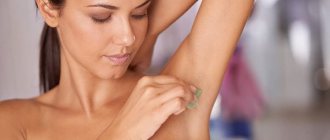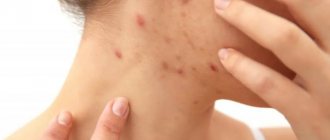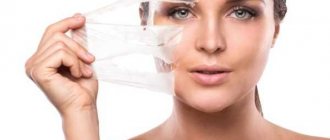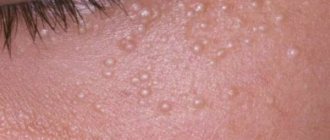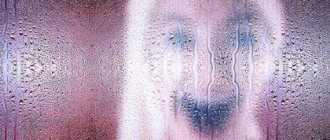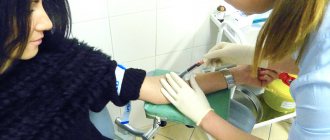Everyone had the feeling that the upper or lower eyelid was itching and itching. But upon closer examination, in most of these cases it turns out that the reason for this is or eyelash that has gotten into the eye .
Having eliminated the source of the discomfort, it is usually easy to get rid of it, but if the itching of the eyelids does not go away over time , and in addition the eyelids begin to peel, the reasons may be much more serious .
Why might the eyelid become red, itchy and flaky?
The eyelid (lower or upper) can become itchy, red, itchy, swollen, and flaky for several common reasons:
- foreign body getting under the eyelid;
- allergic reactions;
- defeat by a viral infection ;
- demodicosis;
- blepharitis;
- skin dermatitis ;
- use (or expired) cosmetics
- reaction to poor quality water (in this case, itching begins after washing);
- reaction to various medications.
Note! In all these cases, only one eye may itch and peel, and only with allergies does such a disorder affect both organs of vision at once.
What types of blepharitis are there?
Based on clinical manifestations, experts distinguish several types of the disease:
- Simple. With this form of blepharitis, the eyelids thicken, a large amount of white-gray secretion accumulates in the corners of the eyes, and the ducts of the meibomian glands are dilated.
- Scaly. On the edge of the eyelids of a patient suffering from this form of the disease, scales similar to dandruff accumulate - parts of the epidermis that stick to the base of the eyelashes.
- Ulcerative. With ulcerative blepharitis, ulcers are formed on the edge of the eyelids, covered with yellow crusts. In the advanced form, after the ulcers heal, scars form that disrupt the growth of eyelashes.
- Rosacea. This form of blepharitis is characterized by the formation of red-gray nodules on the skin, often with ulcers.
- Demodectic. Blepharitis caused by mites of the genus Demodex occurs with unbearable itching, the release of a sticky secretion that dries on the eyelids, redness and thickening of the edges of the eyelids.
- Allergic. Blepharitis of this type is in all cases associated with exposure to an external factor – an allergen. With this form, the eyelids thicken, the skin darkens, there is pain in the eyes, photophobia, lacrimation, and mucous discharge may appear.
Causes
The reason why the eyelids itch, swell, turn red and peel can be determined based on the characteristics of the symptoms.
Eyelids are peeling
If the eyelid does not itch too much, and the patient is more concerned about noticeable peeling of the skin of the eyelids, the reasons may be as follows:
- Damage to the eyelids by eyelash mites , which multiply in the eyelash follicles. Such a violation can occur without any special symptoms and worsen only in the autumn-spring period. In this case, the activity of the mite during certain periods may be accompanied by itching.
- Blepharitis . This is an inflammatory disease of the eyelids, which is provoked by Staphylococcus aureus, less commonly, it occurs when the organs of vision are affected by other infections or allergies.
- Peeling of the eyelids can occur in people who spend too much time at the computer . The likelihood of developing such a symptom may increase if the lighting is not good enough and the air in the room is too dry.
- This phenomenon can be observed in women when using low-quality cosmetics .
- Peeling is a characteristic sign of a lack of vitamin B in the body .
Why do my eyelids itch?
Keep in mind! The eyelids can not only peel, but also itch. In some cases, the itching becomes so unbearable that the patient begins to constantly rub his eyes.
In such cases, there is a risk of additional infections being introduced into the organs of vision .
Itchy eyes are usually a sign of the following ophthalmic diseases:
- Dermatitis of atopic origin . In such cases, itching may be accompanied by uncontrollable profuse lacrimation and discharge from the eyes.
- Allergic dermatitis . This is the main and most common reason why a patient may have itchy eyelids. In this case, a variety of agents can act as allergens - from plant particles to dust, wool and chemical compounds that may be present in varying concentrations in the environment. Allergic reactions can also occur to various cosmetics.
- Blepharitis.
- Ophthalmic rosacea . This is a chronic pathology in which swelling of the eyelid skin and its redness occur.
Red, scaly spots on the eyelids
Sometimes the eyelids do not just itch: individual localized red lesions develop on the skin, which are clearly visible during diagnosis.
Remember! There are two reasons for the appearance of such red spots - allergic eczema (allergic dermatitis) and hemangioma (benign ophthalmic formation).
In the first case, the spots appear in groups, turn red for a short period of time and begin to itch.
This is the body’s reaction to allergens such as cosmetics, household chemicals, medications, hair dye ; in rare cases, certain foods can cause such a disorder.
Treatment of dry eyelids
The tactics to combat dry eyelids depend on the causes of its occurrence. If it lies only in the initially dry skin type or is a consequence of the adverse influence of external factors, it is enough to organize proper eyelid care, avoid contact with aggressive environmental factors and, if necessary, carry out a course of cosmetic procedures.
But if the root of the problem lies in the development of dermatological diseases or disorders in the functioning of internal organs, longer and more complex treatment will be required. In such situations, it will always be comprehensive and aimed not only at moisturizing and nourishing the skin of the eyelids, but also at eliminating detected diseases.
In case of an allergic reaction, antihistamines or corticosteroids are prescribed.
Absolutely all patients who consult a dermatologist with the problem of dry eyelids are recommended to protect their eyes on sunny days, especially in summer, with sunglasses that completely cover the eyelids and protect them from the negative effects of ultraviolet rays, or to apply special sunscreens. It is also worth giving up bad habits, enriching your daily diet with sources of vitamins A, C, E and drinking at least 2 liters of water daily, in addition to other drinks.
Additionally, complex vitamin preparations are prescribed.
Home eyelid skin care
To avoid problems with the skin of the eyelids and the development of diseases, it is important to properly care for it. Dry eyelid skin first of all requires sufficient hydration and protection from external irritants. Therefore, cosmetologists recommend:
- Use only special makeup removers created taking into account the structure of the skin of the eyelids and avoid soap and alcohol lotions when washing. It is important to avoid intense friction and mechanical irritation. It is better to blot the skin with a soft cotton pad soaked in the product.
- Regularly use special creams, masks, serums for the area around the eyes containing humectants and physiological lipids. Do not apply them to the moving eyelid unless this option is written on the packaging. Most products are applied to the orbital bone.
- Apply the cream no later than 1-2 hours before bedtime. Otherwise, there is a high probability of bags under the eyes forming in the morning. The optimal time for eyelid skin care is considered to be from 19 to 22 hours.
- Under no circumstances should you use scrubs and peels to exfoliate the skin of your eyelids.
- Protect your eyes from contact with shampoo, shower gel, and facial cleansers.
Caring for dry skin, including eyelids, should always include 2 types of treatment: gentle cleansing and adequate moisturizing. To cleanse the skin, use soft, non-foaming products, such as micellar water or cold creams. They contain mineral oils, non-ionic detergents (esters and micelles of fatty acids), which carefully dissolve contaminants, including decorative cosmetics. At the same time, they are easily removed from the skin with a cotton pad and do not require friction. In addition, they do not remove natural lipids, in particular cerebrosides and ceramides, which is an additional plus.
In addition, we must not forget that the main cause of dry eyelids is the insignificant thickness of the lipid film and dehydration. Therefore, it is important to focus efforts on maintaining normal levels of moisture and lipids. For this purpose, it is recommended to use cosmetics containing physiological lipids and humectants (hydrants), in particular:
- fatty acids, ceramides, cholesterol;
- glycerin, waxes, mineral and natural oils;
- hyaluronic acid, urea, lactic acid, collagen.
To eliminate severe dry eyelids, you should choose masks and serums. In milder cases and to maintain healthy skin, creams are sufficient.
Humectants ensure that water present in the stratum corneum is introduced deep into the skin. These include: NMF, polyols, liposomes, glycosaminoglycans, elastin, collagen. The NMF system deserves special attention, which includes a variety of water-soluble and hydrophilic substances that are natural to the stratum corneum. One of the brightest representatives of such products is a composition based on pyrrolidonecarbolic acid, urea and lactic acid.
Substances that form a lipid film, on the contrary, help slow down the loss of water through the stratum corneum. These include all compounds that form the oil phase of any cream. This can be petroleum jelly, paraffin, silicones, natural oils rich in polyunsaturated fatty acids, lanolin.
For severe peeling, a dermatologist may recommend keratolytics. But they are used with caution.
Care products are selected individually, taking into account skin type, time of year and other factors. Thus, in late autumn and winter it is recommended to use products containing moisturizers, and in the summer you should avoid using creams containing comedogenic lipids. But the emphasis is always on the ability of an eyelid skin care product to create a protective film.
For atopic dermatitis, ichthyosis and many other dermatological diseases, the use of fatty creams of the “water in oil” type is indicated. Their distinctive feature is the distribution of a small amount of liquid components in a fatty dispersion medium. They effectively solve the problem of dry eyelid skin, loss of elasticity and help reduce superficial inflammatory processes.
It is important to correctly apply care products to both eyelids. This is done exclusively along massage lines with light, patting movements to prevent overstretching of the skin and to avoid premature formation of wrinkles. On the lower eyelid, the cream is applied from the outer corner of the eye towards the nose, and on the upper eyelid, on the contrary, from the nose to the outer corner of the eye.
Cosmetology procedures
Cosmetic procedures are carried out only if the development of dermatological diseases is excluded. Today, biorevitalization and mesotherapy are used to solve the problem of dry eyelids. These procedures involve the introduction of substances into the skin that help moisturize and nourish it.
If dry eyelids are the result of age-related changes, you can additionally fill the nasolacrimal groove and wrinkles around the eyes with fillers, i.e., contour plastic surgery. This will further achieve a pronounced anti-aging effect.
But any cosmetic procedures cannot be performed if:
- oncological diseases;
- exacerbation of herpetic infection;
- acute infectious disease or exacerbation of a chronic disease;
- pregnancy and lactation;
- autoimmune disorders.
Biorevitalization
Biorevitalization is a procedure that involves the introduction of hyaluronic acid into different layers of the skin through multiple point injections or non-injection methods. Patients should understand that biorevitalization does not provide an immediate effect. It increases smoothly within 2 weeks after the procedure and lasts for an average of 6-12 months.
To obtain a pronounced result, a course of procedures consisting of 3-5 sessions will be required. They are carried out at intervals of 2-4 weeks. The exact number of biorevitalization procedures required will be determined by a dermatocosmetologist individually based on the condition of the eyelid skin. In some cases, one course is enough to solve the problem of dry eyelids, while in others, maintenance procedures will be required, the frequency of which is also determined by the doctor for each patient separately.
Biorevitalization can be carried out by injection, but hardware techniques are more often used to treat the delicate skin of the eyelids. In the first case, the procedure involves introducing a specially selected hyaluronic acid preparation into the skin of the eyelid with thin needles. The minimum diameter of the needle ensures minor trauma to the skin and rapid recovery. Injections are performed at a distance of 1-1.5 cm from each other after preliminary cleansing and treating the skin with an antiseptic. To make the procedure less painful, an anesthetic is first applied.
Non-injection biorevitalization is more suitable for working with delicate eyelids. There are several methods for introducing hyaluronic acid into the skin, but most often a laser is used for this purpose. With its help, it is possible to achieve the most uniform distribution of the drug in the tissues and obtain a good moisturizing effect. In addition, it ensures that there are no visible marks on the skin around the eyes, which allows the procedure to be carried out during your lunch break and avoids the need to limit social contacts.
Laser biorevitalization additionally stimulates microcirculation, the synthesis of own collagen and elastin, and also reduces the severity of inflammatory processes.
Mesotherapy
Mesotherapy is very similar to biorevitalization, since it also involves the introduction of special preparations into the skin by injection or non-injection. But unlike biorevitalization, mesotherapy uses complex products containing not only hyaluronic acid, but also other compounds beneficial to the skin.
Preparations for mesotherapy are often called mesotherapy cocktails.
For dry eyelids, mesotherapy cocktails include:
- hyaluronic acid;
- vitamins;
- microelements;
- elastin;
- collagen.
Additionally, the procedure will help eliminate bags and bruises under the eyes, improve the condition of the skin in general and obtain a rejuvenating effect. But to get a good result, you also need to undergo a course of mesotherapy sessions.
Contour plastic with fillers
This type of procedure is purely cosmetic in nature and is used to rejuvenate the skin of the face, including around the eyes, and eliminate deep wrinkles, folds and skin creases. Its essence lies in the use of so-called fillers, which are injected using thin needles directly into the wrinkles around the eyes or nasolacrimal groove, filling the crease and smoothing out the skin texture. In this way, you can eliminate even deep wrinkles and achieve a pronounced rejuvenating effect.
The fillers themselves are most often hyaluronic acid preparations, but, unlike those used for biorevitalization and mesotherapy, they have a denser texture and contain hyaluronic acid with a different molecular weight. But there are also fillers based on collagen, poly-L-lactic acid, calcium hydroxyapatite and other compounds. They differ in the shelf life of the effect, cost, and possibilities of use.
To treat the skin around the eyes, fillers based on hyaluronic acid and collagen are mainly used.
Contour plastic surgery gives an instant and completely natural effect. Moreover, it is completely safe, which makes it a worthy alternative to plastic surgery.
Thus, although dry eyelids do not pose a serious threat, they can still significantly reduce the quality of life and lead to complications. In addition, it can only act as one of the symptoms of the disease, so you should not ignore the problem or try to cope with it on your own. It will be much more effective and rational to contact a dermatologist or qualified cosmetologist. The doctor will accurately determine whether dry eyelids are only a cosmetic problem or indicate more serious problems in the body’s functioning and will select the optimal treatment tactics.
Why might a child's eyelid peel?
Remember! A child's eyelid may itch and peel as a result of damage by viruses and bacteria, or as a result of allergies.
The second case is the most common, since the skin of the eyelids in children is thinner and more delicate than in adults, and therefore it reacts to external stimuli faster.
But for the development of such a pathology, direct contact of the organ of vision with the irritant is not always required: allergens can enter the body with food, as well as when various medicinal ointments and creams are applied to the eyelids .
Itching and peeling can occur with blepharitis , a disease of the eyelids in which the eyelid edge becomes inflamed.
The danger of such a disease is that it is almost impossible to diagnose it in the first and even subsequent stages, especially if the patient has no complaints.
Itching in the corners of the eyes
In ophthalmology, even such a symptom as the desire to constantly scratch the eyelids cannot be ignored.
If your eyes itch rarely, this is an accident, but if this condition turns into constant, persistent itching, this indicates the development of diseases.
Ophthalmologists talk about eye itching as a sign of pathology only if there are accompanying symptoms:
- profuse lacrimation,
- swelling,
- the presence of purulent discharge,
- redness.
Prevention
You can avoid peeling and itching of the eyelids by following these recommendations:
- avoid using low-quality and expired cosmetics ;
- observe the rules of personal hygiene and try to prevent dust and dirt from getting into your eyes;
- if you are prone to allergic reactions, it is necessary to minimize contact of the organs of vision with allergens ;
- avoid long periods of time at the computer , and if this is necessary for work, if you feel discomfort, instill moisturizing ophthalmic solutions;
- if you need to use contact optics, you should buy such products only after consulting an ophthalmologist ;
- At the first symptoms of eye diseases, visit a doctor .
As a preventative measure, you can use herbal decoctions , which can be used every morning to wash your face.
You can use cucumber water to wipe your eyes. It is also useful to wash your face and rinse your eyelids with a solution of tar soap at least two to three times a week, but you need to make sure that the liquid does not get into your eyes.
How to recognize blepharitis?
There are common symptoms of blepharitis. These include:
- photophobia;
- rapid eye fatigue when reading;
- feeling of heavy eyelids;
- swelling, redness (especially in the morning after waking up);
- thickening and swelling of the ciliary edge of the eyelids;
- feeling of “sand in the eyes”;
- itching;
- eyelash loss;
- the appearance of discharge and gluing of the eyelids;
- the appearance of dry crusts on the ciliary edge of the eyelids.
If one or more of these signs appears, you should contact an ophthalmologist to make an accurate diagnosis and prescribe the most effective treatment.
Fucithalmic
The gel will help against inflammation of the eye mucosa; it is effective for keratitis, blepharitis, and conjunctivitis. Has an antibacterial effect. Used as prophylaxis after eye surgery. Contraindication is personal intolerance. The drug is used for a week. If suddenly, when using the gel, a burning sensation, swelling, or urticaria appears, you should urgently stop the drug and seek medical help. When using this gel, you should not wear contact lenses.
An analogue of the drug is Floxal ointment. After opening the bottle, you can use the gel for no more than a month.
Solcoseryl
The gel helps restore cells in the eye mucosa. If a person has damage to the cornea or inflammation of the mucous membrane, this drug is simply irreplaceable. The composition includes carmellose sodium, which is able to protect the cornea for quite a long time. This gel is suitable for cataracts, conjunctivitis and glaucoma. If other eye medications are used, at least twenty-five minutes should elapse between their use. Contraindications for use are:
- pregnancy;
- children under one year of age;
- individual intolerance.
The gel should be used several times a day as directed by your doctor. The duration of use is determined individually.
